Synchronizing actions among the other CP cells, elements, meetings (including boards and working groups), and other entities (such as personal and special staff sections that operate independently).
AIRSPACE COMMAND AND CONTROL ELEMENT
2-153. The airspace command and control element oversees the airspace command and control function.
This includes providing tactical airspace requirements to the main CP airspace command and control element and integrating tactical operations with the main CP airspace command and control element.
AVIATION ELEMENT
2-154. The aviation element coordinates and synchronizes the execution of aviation maneuver, unmanned assets, and sustainment operations when the tactical CP operates independently.
ENGINEER ELEMENT
2-155. The engineer element coordinates with the primary engineer element at the main CP and advises the CG and staff on current operations requirements to enable freedom of movement and maneuver and protection. This element also recommends how to allocate and use engineering assets to fulfill those near-term requirements. It coordinates the application of the engineer functions (combat, general, and geospatial 2-34
FM 3-92
26 November 2010
Corps Headquarters
engineering). With a focus on the movement and maneuver function, the engineer element coordinates and synchronizes engineer operations within the tactical CP and with other headquarters, between echelons, and with multinational forces and governmental and nongovernmental organizations as required.
JUDGE ADVOCATE ELEMENT
2-156. The judge advocate element provides support in all legal disciplines, including advice on—
z
Rules of engagement.
z
Rules of law activities.
z
Stability operations.
z
Treatment of detainees.
z
Lawfulness of targets and weapons.
z
The law of war.
FIRES CELL
2-157. The tactical CP fires cell is led by the deputy chief of fires who may locate elsewhere as the situation requires. The cell consists of an assistant fire support coordinator, fire support noncommissioned officers, and fire support specialists. Normally, the tactical CP fires cell executes lethal fires and nonlethal activities for a specific operation or for short durations. The fires cell may require additional augmentation from the main CP fires cell, depending on mission requirements.
2-158. The fires cell—
z
Plans fires.
z
Requests and coordinates close air support and air interdiction.
z
Interfaces with the battlefield coordination detachment, air liaison officer, Army and joint airspace control elements, and higher and joint fires elements.
z
Coordinates air requirements through the battlefield coordination detachment at the ARFOR
liaison to the joint force air component command with the corps air liaison officer.
z
Synchronizes Army, joint, interagency, and multinational lethal fires and nonlethal activities.
z
Conducts combat assessments and recommends reattacks.
z
Coordinates with special operations forces in the corps AO.
z
Coordinates with Army and joint airspace control elements.
z
Coordinates with higher and joint fires elements.
PROTECTION CELL
2-159. The protection cell includes the following elements:
z
Provost marshal office.
z
Air and missile defense.
z
Chemical, biological, radiological, and nuclear (CBRN).
PROVOST MARSHAL ELEMENT
2-160. The provost marshal element does the following:
z
Tracks current operations.
z
Recommends the employment of military police assets.
z
Coordinates military police support for ongoing operations, including processing of detainees.
26 November 2010
FM 3-92
2-35
Chapter 2
AIR AND MISSILE DEFENSE ELEMENT
2-161. The air and missile defense element plans, coordinates, and synchronizes air and missile defense operations. This includes the following:
z
High-value target protection analysis.
z
Coordination with main CP and external organizations.
CHEMICAL, BIOLOGICAL, RADIOLOGICAL, AND NUCLEAR ELEMENT
2-162. The CBRN element is responsible for the following:
z
Providing 24-hour operations.
z
Advising the CG and staff on all CBRN issues.
z
Overseeing immediate CBRN logistics functions.
z
Contributing to information superiority analysis-track key indicators.
z
Performing CBRN response analysis.
z
Coordinating for and providing input to estimates (intelligence and vulnerability analysis), orders, and plans.
z
Recommending the employment of CBRN assets.
z
Supporting the CBRN warning and reporting system managed by the main CP.
SUSTAINMENT CELL
2-163. The sustainment cell monitors, collects, assesses, prioritizes, and executes all sustainment functions at the tactical CP, including movement operations, asset in-transit visibility, and requirements estimation. It provides input to the COP.
COMMAND AND CONTROL CELL
2-164. The command and control cell includes support from the corps headquarters battalion tactical CP
signal systems support team. As with the main CP command and control cell, the tactical CP can include civil affairs, psychological operations, and information engagement elements if required. The command and control cell—
z
Synchronizes and integrates information engagement components (public affairs, combat camera, strategic communications, defense support to public diplomacy, and leader and Soldier engagement).
z
Integrates psychological operations.
z
Integrates civil affairs operations.
z
Coordinates network operations support.
z
Plans and executes computer network defense.
z
Synchronizes and integrates information assurance.
z
Establishes and monitors information protection and communications security.
z
Installs, operates, maintains, and defends NIPRNET and SIPRNET. Manages the installation and operation of local area networks, including cable and wire installation and troubleshooting.
z
Monitors, manages, and controls organic communications systems.
z
Performs, as required, network operations functions, including enterprise management, electromagnetic spectrum operations, information dissemination management, and information assurance.
z
Installs, operates, and maintains information services within the information network enabling all battle command functions across all corps and below formations.
2-36
FM 3-92
26 November 2010
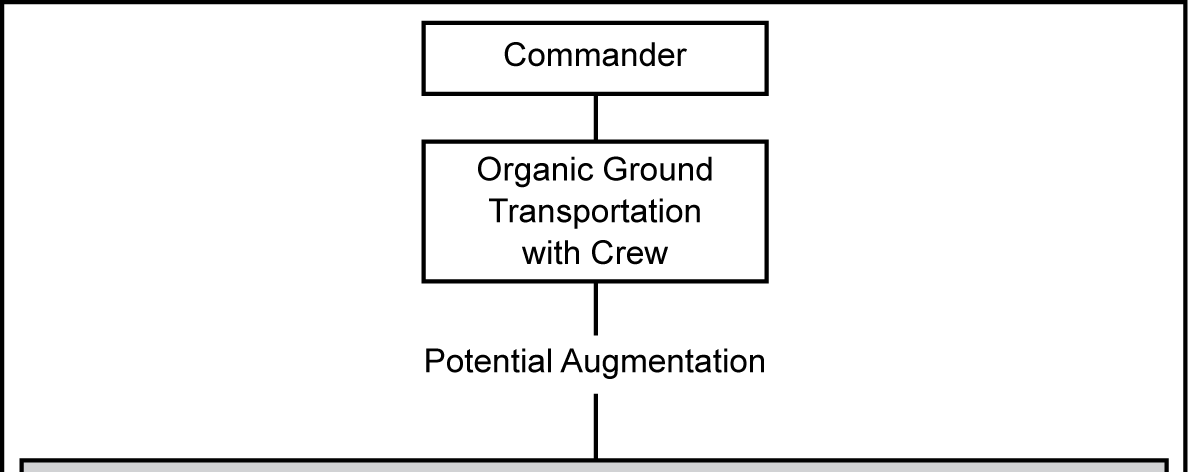
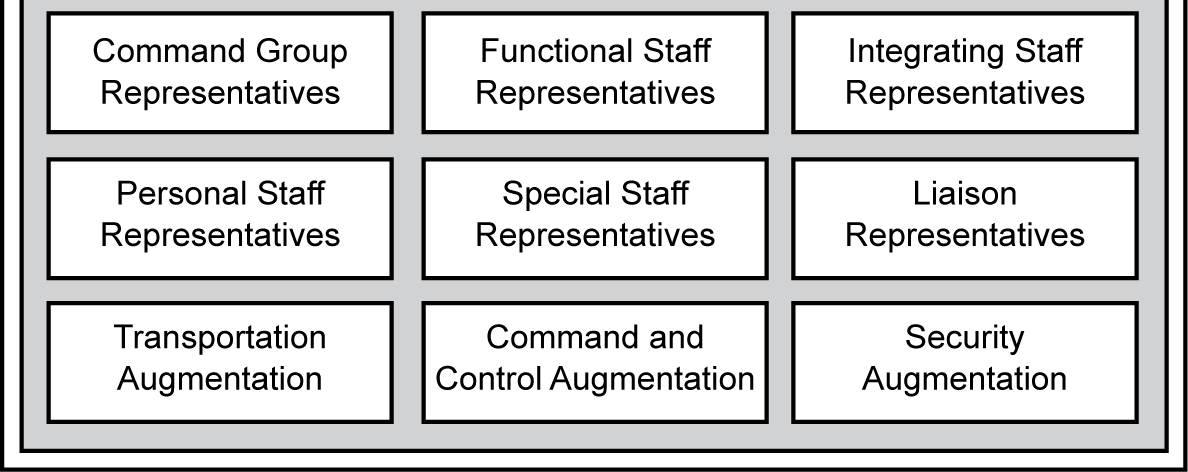
Corps Headquarters
SECTION IV – ADDITIONAL COMMAND AND CONTROL FACILITIES
2-165. There are two temporary command and control facilities that may see action depending on the situation: the mobile command group and the early-entry CP. Subordinate forces may form a third type of facility, the center, to exercise command and control of all or part of a function.
MOBILE COMMAND GROUP
2-166. The mobile command group is the CG’s mobile CP. It permits the CG to exercise command and control while on the move. The mobile command group has two armored wheeled vehicles, each with a crew and elements of the Army Battle Command System suite of terminals. Its composition depends on the CG’s desires and the situation. The group is augmented as required, including additional vehicles, communications equipment, and security. If aerial transportation is required, the corps requests aviation assets from the theater aviation command or brigade or other aviation assets. (See figure 2-11 for a possible mobile command group composition.)
Figure 2-11. Mobile command group
EARLY-ENTRY COMMAND POST
2-167. Occasionally the CG needs to establish a CP at a remote location ahead of other corps headquarters elements. In those circumstances, the corps creates and deploys an early-entry CP. The early-entry CP may deploy and set up alone. Alternatively, it may colocate with another Army CP, a joint CP, an interagency or multinational organization, or a host-nation command and control facility.
2-168. The early-entry CP is usually organized and tailored around the tactical CP. It draws equipment and personnel from the tactical CP, main CP, and other corps communications and security elements. The CG staffs the early-entry CP with a mix of current operations personnel able to coordinate the reception of the corps and plan its initial operations. The corps standing operating procedures normally designate the sources of personnel and equipment. Depending on the situation, the CG may augment the early-entry CP
with such capabilities as language and regional expertise.
2-169. The corps early-entry CP performs the functions of the main and tactical CPs until those CPs are deployed and fully operational. A deputy commander, chief of staff, or assistant chief of staff for operations leads the early-entry CP.
26 November 2010
FM 3-92
2-37


Chapter 2
CENTERS
2-170. A center is a command and control facility established for a specific purpose. Centers are similar to CPs in that they are facilities with staff members, equipment, and a leadership component. However, centers have a more narrow focus and are normally formed around a subordinate unit headquarters. For example, a civil affairs unit under corps control may establish a civil-military operations center or a logistics organization supporting the corps may establish movement control centers.
SECTION V – AIR FORCE SUPPORT TO THE CORPS
2-171. Air Force support to the corps headquarters consists of a corps tactical air control party, staff weather officer, and the air mobility liaison officer. These Air Force elements function as a single entity in planning, coordinating, deconflicting, and integrating the air support operations with ground elements. Air mobility liaison officers advise ground commanders and staffs on the capabilities and limitations of air mobility assets. The Air Force provides tactical control parties to Army maneuver unit headquarters down to the combined arms battalion. Additionally, the Air Force pools terminal attack control teams to provide support down to the maneuver company level as required. See appendixes B and E for additional information. When serving as a senior tactical echelon the corps will normally have an air support operations center.
SECTION VI – CORPS HEADQUARTERS AND HEADQUARTERS BATTALION
2-172. The only troops organic to the corps are in the headquarters battalion. The battalion is commanded by a lieutenant colonel. It consists of the battalion command group, headquarters battalion staff, and four companies. (See figure 2-12.) The subordinate elements of each company report to the company chain of command. The company commander, in turn, reports to the headquarters battalion commander.
Figure 2-12. Headquarters battalion
BATTALION COMMAND GROUP
2-173. The battalion command group provides supervision and exercises command and control of personnel assigned to the corps headquarters. It consists of a commander, executive officer, command sergeants major, rear detachment commander, rear detachment noncommissioned officer, and a vehicle drive. The battalion commander also serves as the headquarters commandant for the corps headquarters.
2-38
FM 3-92
26 November 2010
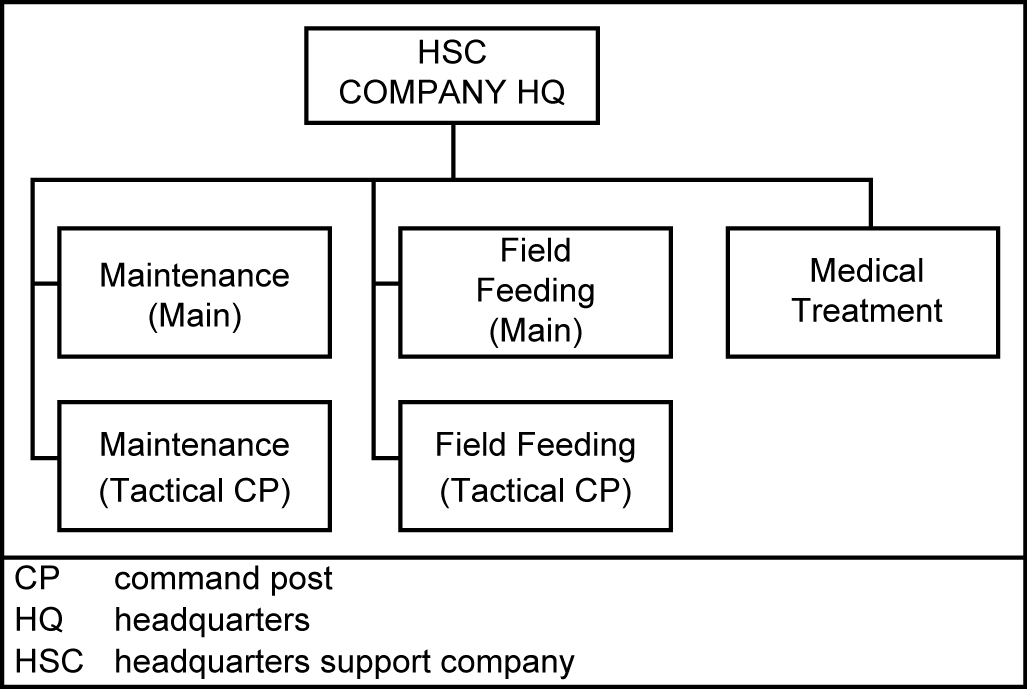
Corps Headquarters
2-174. The battalion provides communications, transportation, and medical support to the corps headquarters. The battalion’s personnel, equipment, and services are split among the main CP, tactical CP, and mobile command group. The battalion provides administrative and life support to the additional resources assigned or attached to the corps headquarters—such as a band, security assets, and joint or interagency augmentation—as required.
BATTALION STAFF
2-175. The headquarters battalion staff consists of five staff sections. They provide administrative, human resources, logistic support, religious support, and life support to corps headquarters elements in garrison and the field. When deployed, the battalion staff sections are responsible for unit-level command and control, communications support, property accountability, transportation, medical, food service, and maintenance support for the main CP, tactical CP, and mobile command group.
HEADQUARTERS SUPPORT COMPANY
2-176. The headquarters support company contains the components shown in figure 2-13. All members of the headquarters battalion staff are assigned to the headquarters support company.
Figure 2-13. Headquarters support company
MAINTENANCE SECTIONS FOR MAIN AND TACTICAL COMMAND POSTS
2-177. The headquarters support company has two sections that support headquarters battalion Soldiers in the corps CPs, one for the main CP and one for the tactical CP. When deployed these sections provide command and control and the following support to the personnel assigned to the respective CPs: maintenance and field feeding.
MEDICAL TREATMENT SECTION
2-178. The medical treatment section provides Army Health System support for the corps main CP
personnel as well as emergency and advanced trauma management to main and tactical CP personnel. It also provides sick call services, medical surveillance and preventive medicine, and unit-level ground and en route patient care.
OPERATIONS COMPANY
2-179. The operations company (A Company) provides company-level administrative and logistic support to Soldiers in the movement and maneuver cell, protection cell, and fires cell, as well as the tactical CP
26 November 2010
FM 3-92
2-39
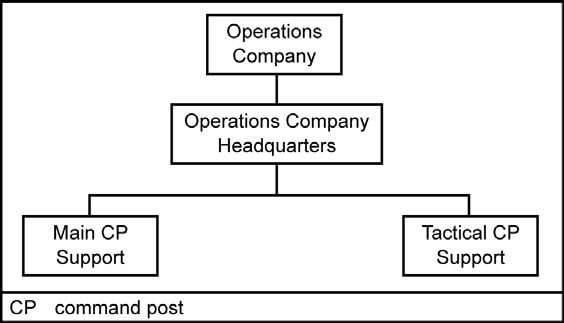
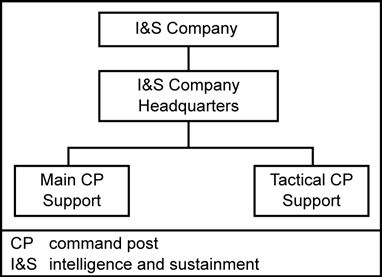
Chapter 2
elements of these cells. When the tactical CP deploys, the headquarters and headquarters battery commander may direct the operations company headquarters to deploy as well, to synchronize all aspects of support to the tactical CP from the headquarters and headquarters battery. (See figure 2-14.) Figure 2-14. Operations company
INTELLIGENCE AND SUSTAINMENT COMPANY
2-180. The intelligence and sustainment company (B Company) provides company-level administrative and logistical support to the Soldiers in the intelligence cell and the sustainment cell, as well as the tactical CP elements of these cells. When the tactical CP deploys, the headquarters and headquarters battery commander may direct the intelligence and sustainment headquarters to deploy as well so to synchronize all aspects of support to the tactical CP from the headquarters and headquarters battery. (See figure 2-15.) Figure 2-15. Intelligence and sustainment company
SIGNAL COMPANY
2-181. The signal company provides information network and communications support to the corps headquarters. It includes platoons that directly support the corps main and tactical CPs. (See figure 2-16, page 2-41.) Signal Soldiers supporting the corps CPs are assigned to and receive their administrative support from the signal company.
2-40
FM 3-92
26 November 2010


Corps Headquarters
Figure 2-16. Signal company
COMPANY HEADQUARTERS
2-182. The signal company headquarters provides logistic support to the company. The company receives maintenance support from the headquarters battalion. The company headquarters oversees installation and operation of the following support for the main and tactical CPs, and others as directed: z
Network.
z
Radio (line-of-sight and satellite communications).
z
Wireless network extension.
z
Wire.
z
Cable.
MAIN AND TACTICAL COMMAND POST SUPPORT PLATOONS
2-183. Each CP support platoon provides communications support using the joint network node to connect user devices such as telephones and computers. The two platoons have nearly identical capabilities to provide terrestrial and space-based communications support to each CP. Platoon capabilities include secure tactical defense switched network voice, NIPRNET, SIPRNET, Joint Worldwide Intelligence Communications System, and video teleconferencing. The tactical CP has the wireless network extension teams for extended frequency modulation retrains. The platoon cable section provides support to the main CP and tactical CP on a mission basis.
CIVILIAN, CONTRACTOR, AND OTHER AUGMENTATION
2-184. The Army is supported by Army civilians, contractors, and other partners during peace and war.
As combat multipliers, they perform critical duties in virtually every facet of Army operations at home and when deployed.
ARMY CIVILIANS
2-185. Army civilians have long been an integral part of the Army team. They fill key leadership and support positions. The augmentation for a typical corps includes civilian employees in almost every part of the organization. This is true especially for a corps based overseas. There, many civilians serve in host-nation relations, maneuver management, programs such as Partnership for Peace, and plans and operations.
Many of these positions require continuity, such as historian, protocol, safety office, training division, special security office, budget office, and transportation.
26 November 2010
FM 3-92
2-41
Chapter 2
2-186. Army civilians with critical skills may deploy. The corps headquarters plans for civilian deployment regardless of the projected or actual corps mission. The headquarters identifies emergency essential civilians during deployment planning. Emergency essential positions meet two criteria. They cannot be converted to uniformed positions without a loss of continuity of performance. And they are required to ensure the success of combat operations or to support combat-essential systems. In unforeseen situations, Army civilians in positions not previously identified as essential can be required to deploy.
2-187. During military operations and once medically cleared, Army civilians fall under the military chain of command. They perform their specialty just as they would before deployment with regards to evaluations, assignments, discipline, and recognition. The corps is responsible for predeployment training, life, and other support for deployed Army civilians, including physical security. (See Department of the Army Pamphlet (DA Pam) 690-47 for more information.)
CONTRACTORS
2-188. Contractors’ contributions to deployed forces include support other than direct participation in hostile actions in sustainment, language services, communications, and infrastructure.
2-189. Frequently, a desire to limit the presence of U.S. forces in a region leads to a cap on the number of Service members deployed. When military force caps are imposed, contractor support allows commanders to maximize the number of combat Soldiers by replacing military support units with contractor support.
This force-multiplier effect lets the combatant commander provide sufficient support in the theater of operations while strengthening the deployed force’s fighting capability. At the conclusion of operations, contractors also facilitate early redeployment of forces.
2-190. In the initial stages of an operation, supplies and services provided by local contractors improve response time and free strategic airlift and sealift for other priorities. Contractor support drawn from resources in the theater of operations augments existing support capabilities to provide a new source of critically needed supplies and services.
2-191. The corps should identify and provide qualified personnel as required by supporting contracting units and organizations to serve as contracting officer representatives. These representatives must be familiar in the goods or services provided by the contracts they help administer as well as trained, appointed, and managed by a contracting officer to whom they report. Contracting officer representatives ensure contractors provide the goods and services as specified in the supported unit’s statement of work, thereby ensuring the supported unit receives the support necessary to support their mission.
UNIFIED ACTION
2-192. Within the U.S. Government, Army and other government agencies perform in both supported and supporting roles with other commands and agencies. However, this support command relationship differs from that described in joint doctrine. Relationships between the Army and other government agencies and organizations do not equal the command and control of a military operation. Whether supported or supporting, close coordination between the military and other agencies is key. (See JP 3-08.) 2-193. Coordination and integration among the joint force and other civil and military, joint and multinational organizations does not equal the command and control of a military operation. Military operations depend upon a command structure that differs from that of civilian organizations. These differences may present significant challenges to coordination efforts. The various government agencies’
different—and sometimes conflicting—goals, policies, procedures, and decisionmaking techniques make unity of effort a challenge. Still more difficult, some intergovernmental and nongovernmental organizations may have policies that are explicitly antithetical to those of the United States, and particularly U.S. forces.
2-42
FM 3-92
26 November 2010
Chapter 3
Corps Headquarters Operations
This chapter describes the corps headquarters operations as a command and control
headquarters. It highlights the importance of the support to the corps headquarters
and their command and support relationship. It discusses the placement of the corps
headquarters for command and control during operations and also how the corps uses
its command and control systems throughout the operation.
SUPPORT TO CORPS HEADQUARTERS
3-1. Exercising command and control of land forces for operations is the corps headquarters’ first priority. The corps is capable of carrying out this mission alone, but it is often augmented with personnel to assist the commander and staff in accomplishing their assigned tasks and missions. The types and quantity of augmentation depends on the situation and normally arrives from theater army assets or from the available Army force pool. The augmentation timeframe can be temporary or can last the entire operation.
For example, the plans cell and the movement element of the movement and maneuver cell may receive the greatest command attention and resources during the predeployment phase. The augmentation to the corps headquarters may be limited in time and scope to support the successful deployment of the corps headquarters. While deployed and engaged in sustained major combat land operations in an area of operations (AO), the current operations integration cell may be the center of attention and receive the majority of augmentation
3-2. In its role as an intermediate tactical headquarters, the corps headquarters can exercise command and control of mixed brigades and divisions, as well as joint or multinational forces supported by theater assets.
To control this force mix, the corps headquarters serves as a hierarchical organization combining the commanding general (CG), staff cells, and associated liaison elements into an integrated whole. As such the corps headquarters organizes to control a wide array of assets. To command and control this force mix, the commander relies on staff execution and optimizing available command and control systems within the corps headquarters. Staff execution through functional and integrating cells, to include personal and special staff coordination, enables the commander to control a wide array of assets.
3-3. Corps headquarters augmentation happens during all phase of predeployment, deployment, and redeployment. During major operations. Assets not available in theater are requested from the force generating base and from Army commands and direct reporting units (See Field Manual (FM) 1-01).
Representative force generating force organizations include—
z
Headquarters, Department of the Army.
z
Headquarters, United States Army Forces Command.
z
United States Army Training and Doctrine Command.
z
United States Army Reserve Command.
z
United States Army Special Operations Command.
z
United States Army Materiel Command.
z
United States Army Medical Command.
z
United States Army Space and Mi












